Goats in the Woods
Posted on July 18, 2014 in Science
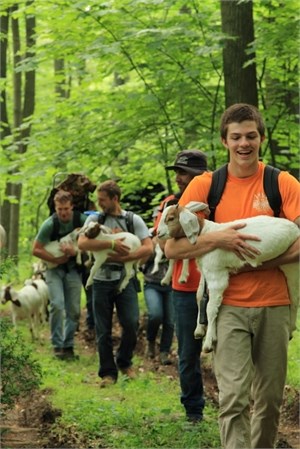
This summer, Hawk Mountain Sanctuary embarked on a wooly experiment: testing the use of goats as a no-chemical alternative to invasive plant removal.
“It was certainly an experience,” laughs Hawk Mountain Director of Land and Facilities Todd Bauman, and he’s not kidding. Testing goats required herders, and mapping areas of invasion with GPS units to measure success over time. Goats also had to be supplemented with hand-pulling and other removal applications to compare the effectiveness of removal methods.
All this fuss for one deceivingly lovely-looking groundcover: Asian stiltgrass,
Microstegium vimineum, sometimes called Japanese packing grass, and a major threat to natural areas. Stiltgrass was introduced to the United States in 1919, likely through its use as packing material for porcelain. The bright green invasive quickly forms dense stands and in short time, chokes out native plants and tree seedlings, reduces biodiversity, and depletes the overall health of the ecosystem.
“Even deer won’t eat it, and because the Sanctuary is bisected with a road, water runoff carries the seeds far into the forest and down to lower-level riparian areas,” explains Bauman.
In such areas, invasive plant control becomes an even bigger challenge. “Riparian habitats are ecologically sensitive, so using a chemical spray isn’t an option there. The chemicals will spread, so you can’t limit it to the siltgrass, and that negatively affects the native species,” he says. As part of its overall management plan, the Sanctuary started in 2013 to use a target-specific herbicide on stiltgrass where it grows in low-quality habitat, such as along the roadway and around edges of parking lots.
For the more sensitive areas, enter the goats, and with interest and support from the Pennsylvania Department of Conservation and Natural Resources and the Schuylkill County Conservancy, the Sanctuary received funding for materials as well as oversight. Other partners included local goat farmers, including a Pennsylvania Game Commission land supervisor, and local landowners interested in using goats on their own properties.
“Hawk Mountain was interested in testing goats, and forester Frank Snyder recommended a presentation I could attend, and also recommended that I talk with Tracey Coulter, agroforestry coordinator at DCNR. Tracey had more contacts, and soon we had a group interested in following this project and offering advice along the way,” Bauman says.
At the Sanctuary, three seasonal staff and one intern served as the on-site invasive plant removal team, and also were responsible for the goats. They mapped areas to pilot, erected portable electric fencing, and then during the first pilot test, carried 11 kids to the site. Here they introduced them to their new food source—lush, green invasive stiltgrass. With the kids came five adults, but it quickly became apparent that lactating adults and kids, or perhaps the relatively young age of the grass, just didn’t work.
“The goats during our first round simply would not eat the stiltgrass,” Bauman admits, “so it was disappointing, but the team wasn’t ready to give up. The question became ‘why,’ and if other goats already proven to eat the grass could be identified, we were happy to try it again.”
And so they did. From south central Pennsylvania came four more adults who did, in fact, graze happily on the stiltgrass along with some other vegetation for the remaining two weeks of the project. The goats are now gone, but the area where they grazed will be studied for re-growth to gauge effectiveness.
Coulter says the experiment had mixed results, but was a learning experience and one she can share with other private landowners. “We do know that animals learn to eat from one another and when introduced to an alien food source they may refuse to eat it. And while adorable, we also can now recommend that you don’t include kids with the does. Finally, definitely do first confirm that the herd will eat the target species before moving them to your site,” Coulter says.
About Japanese Stiltgrass
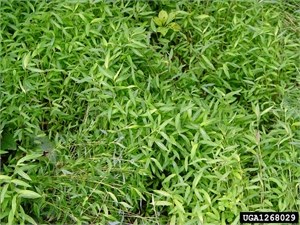
Who knew grass could be so aggressive and damaging? Japanese stiltgrass was introduced to the United States in Tennessee in 1919 and has since spread to most of the states east of the Mississippi, appearing in Pennsylvania in 1938. Well-adapted to low light conditions, Japanese stiltgrass seriously threatens forest communities and once introduced, will easily develop into a thick lawn in a forest understory.
Individual stiltgrass plants produce anywhere from 100 to 1,000 seeds that fall close to the parent plant, but then e carried by water currents during heavy rains or moved in contaminated hay, soil and more often, on footwear. The seeds remain viable in the soil for five or more years and, unfortunately, germinate readily, so eradication plan must continue over the long-term. At nature destinations like Hawk Mountain and at state, federal and other private parks, the species typically appears first at the trailheads where the seeds are carried in on hikers' boots. Abundant populations of white-tail deer may also help the invasion by feeding on native plant species and avoiding stilt grass.
Integrated Invasive Plant Research Project at Hawk Mountain
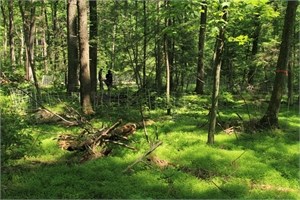
The goats are just the beginning. Hawk Mountain, with financial support from the United States Department of Agriculture’s Natural Resources Conservation Service, has launched a five-year-long conservation plan to treat invasive stiltgrass, barberry and other invasives with a goal of controlling or eradicating it in areas. Areas of highest invasion were identified and mapped, and each year, areas will be mapped again to show changes in the re-growth, and success of different strategies over others.
Application of herbicide began in 2013 along roadways and parking areas, the areas of lowest quality habitat, and weed whacking, hand pulling, and goats were used in forested and riparian areas. Next year, the process begins again, and goats may or may not return.
“If funding were provided, we certainly would be open to experiment with livestock again,” says Bauman, “but the main point is to continue to use some method consistently for several consecutive years and then re-evaluate the best management practices.”
Some Eco-Goat Facts:
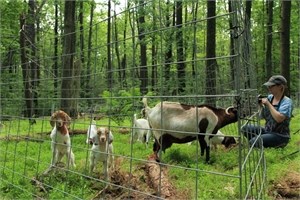
Goats have been used by the U.S. Fish and Wildlife Service, the Bureau of Reclamation and the Bureau of Land Management, and the U.S. Forest Service, and have been used by Pennsylvania Department of Conservation and Natural Resources at two state parks for weed and invasive species control.
Some corporations such as Google are now using goats to manage vegetation because it’s a clean air alternative to noisy gas-powered mowers and weed whackers.
Goats are agile and light on their feet, so can have less impact at historical and natural sites of importance.
Goats will graze all day and respect electric fences, making them an easy source of mobile containment.
Goats have a narrow, triangular mouth that allows them to crush what they eat, so seeds that might otherwise get passed through to fertilization are not viable. This is a true advantage, since machine cutting only encourages further growth in the next growth cycle.
Goats have special enzymes in their guts that allow them to eat plants that are poisonous to other animals.
Controlling Invasives
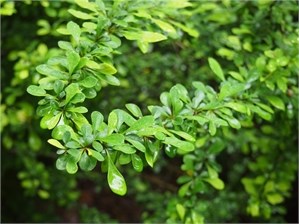
The very best practice with any invasive species is to prevent an invasion in the first place. If Japanese stilt grass, barberry or another invasive is not yet in your area, keep it out by being sure to brush your boots after visiting forested areas and taking care not to carry the invader into new places on your own boots.
Stiltgrass: For very small infestations, simply pull the plants out of the ground before they flower. For larger areas, weed-whack the plants to the ground shortly before it produces seed but too late for it to regrow before the first frost. Late June and early July is a good time to do this.
Barberry: Wear protective clothing, as barberry has thorns. Clip back the bush as much as possible, to the base, leaving one 'stem' to help pull. Do this in summer before the plant produces berries. Now dig up the bush or pull out using a chain/cumalong.
The key for any invasive species is to prevent the plants from setting seed, which is all you need to do to eliminate the species from an area. Remember to pull or mow areas again each year for consecutive years until you're sure all seeds are gone from your site.
For extensive infestations, where mechanical methods are impractical or sometimes impossible, an herbicide is effective when plants are sprayed between June and August, while actively growing but before flowering. Spraying is generally more effective earlier in the summer and less effective during drought periods.
Goats are a new tool in the battle against invasives, and could help remove both species by eating, especially in areas that are difficult to reach, or in areas with poison ivy. While the ability of goats in eating stiltgrass is still experimental, they have been proven to eat a wide range of unwanted vegetation, including bittersweet, multiflora rose, Japanese honeysuckle, mile-a-minute and more.
Land Management at Hawk Mountain
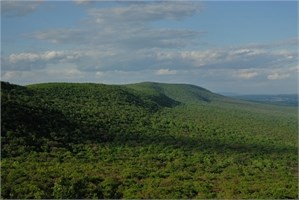
Hawk Mountain Sanctuary is the world’s first refuge for birds of prey and an international center for raptor conservation. Operated as a not-for-profit and celebrating 80 years in 2014, Hawk Mountain manages a 2,500-acre natural area open to the public by fee or membership. Here the views of migratory raptors are stunning, and people flock each spring and autumn to see the annual flights. At other times of the year, visitors enjoy the Sanctuary for hiking, wildlife photography and to enjoy the scenic views from its ridgetop lookouts.
Staff and volunteers help to manage Sanctuary lands as guided by The Hawk Mountain Land Management Plan. Major threats in land management include the spread of invasive plants, managing stormwater runoff, and deer over-browsing, among others. The goal of the land management plan is to maintain the highest diversity and quality of habitat for wildlife, and serve as a model to other natural areas. To that end, more than half of all Sanctuary lands are closed to the public to lessen impact. For its efforts, Hawk Mountain is a federally designated National Natural Landmark, a Pennsylvania Stewardship Forest, an Important Bird and Important Mammal Area, and is located along the designated ‘mega greenway,’ the Kittatinny Ridge.